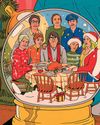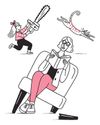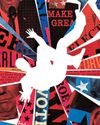The canon in question at the Met.

The first room of “Epic Abstraction: Pollock to Herrera,” a wishfully canon-expanding show of painting and sculpture from the past eight decades, at the Metropolitan Museum, affects like a mighty organ chord. It contains the museum’s two best paintings by Jackson Pollock: “Pasiphaë” (1943), a quaking compaction of mythological elements named for the accursed mother of the Minotaur, and “Autumn Rhythm (Number 30)” (1950), a singing orchestration of drips in black, white, brown, and teal enamel—bluntly material and, inextricably, sublime. There are six Pollock drawings, too, and “Number 7” (1952), one of his late, return-to-figuration paintings in mostly black on white, of an indistinct but hieratic head. The adjective “epic” does little enough to honor Pollock’s mid-century glory, which anchors the standard arthistorical saga of Abstract Expressionism—“The Triumph of American Painting,” per the title of a 1976 book on the subject by Irving Sandler—as a revolution that stole the former thunder of Paris and set a stratospheric benchmark for subsequent artists. The movement has generated both awe and discomfort, like a pet whale, among makers, students, and lovers of art ever since.
Advance notice of this show, which features abundant work by women and African-Americans and a few pieces from Europe, Latin America, and Japan, seemed to bode challenges to the heroic myth. This made me a bit nervous—I was weaned on Abstract Expressionism—but I was also game, as one must
Bu hikaye The New Yorker dergisinin January 7, 2019 sayısından alınmıştır.
Start your 7-day Magzter GOLD free trial to access thousands of curated premium stories, and 9,000+ magazines and newspapers.
Already a subscriber ? Giriş Yap
Bu hikaye The New Yorker dergisinin January 7, 2019 sayısından alınmıştır.
Start your 7-day Magzter GOLD free trial to access thousands of curated premium stories, and 9,000+ magazines and newspapers.
Already a subscriber? Giriş Yap

YULE RULES
“Christmas Eve in Miller’s Point.”

COLLISION COURSE
In Devika Rege’ first novel, India enters a troubling new era.

NEW CHAPTER
Is the twentieth-century novel a genre unto itself?

STUCK ON YOU
Pain and pleasure at a tattoo convention.

HEAVY SNOW HAN KANG
Kyungha-ya. That was the entirety of Inseon’s message: my name.

REPRISE
Reckoning with Donald Trump's return to power.

WHAT'S YOUR PARENTING-FAILURE STYLE?
Whether you’re horrifying your teen with nauseating sex-ed analogies or watching TikToks while your toddler eats a bagel from the subway floor, face it: you’re flailing in the vast chasm of your child’s relentless needs.

COLOR INSTINCT
Jadé Fadojutimi, a British painter, sees the world through a prism.

THE FAMILY PLAN
The pro-life movement’ new playbook.

President for Sale - A survey of today's political ads.
On a mid-October Sunday not long ago sun high, wind cool-I was in Harrisburg, Pennsylvania, for a book festival, and I took a stroll. There were few people on the streets-like the population of a lot of capital cities, Harrisburg's swells on weekdays with lawyers and lobbyists and legislative staffers, and dwindles on the weekends. But, on the façades of small businesses and in the doorways of private homes, I could see evidence of political activity. Across from the sparkling Susquehanna River, there was a row of Democratic lawn signs: Malcolm Kenyatta for auditor general, Bob Casey for U.S. Senate, and, most important, in white letters atop a periwinkle not unlike that of the sky, Kamala Harris for President.